Technology
AI For A Billion: 'Open Cloud Compute' Is India’s Answer To Big Tech’s Compute Monopoly
Karan Kamble
Nov 30, 2024, 12:20 PM | Updated Jan 22, 2025, 10:49 AM IST
Save & read from anywhere!
Bookmark stories for easy access on any device or the Swarajya app.
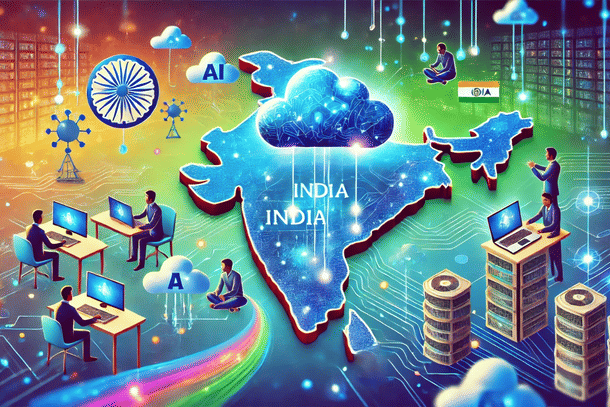
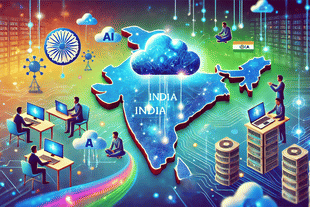
Development and consumption of artificial intelligence (AI) is expected to grow at an unprecedented pace globally, reshaping industries and potentially defining the course of this century. India wouldn’t want to watch from the sidelines. If anything, it would want to be counted as among the leaders in this transformative era, especially in delivering impactful AI-powered applications tailored to its billion-wide population.
Broadly speaking (and simplifying), the development of AI, or any modern technology, stands on three pillars. Two of them might be familiar to us because of how commonly they feature in the media — data and models. It is also perhaps well understood that large datasets are fed into sophisticated models to produce the impressive AI systems we use today.
The third, lesser-discussed pillar is compute. Compute serves as the power source for AI models, if you will, enabling data to be processed, analysed, and transformed into meaningful outcomes. Without sufficient compute, even the most advanced datasets and models cannot deliver groundbreaking results like OpenAI’s ChatGPT or Anthropic’s Claude. Compute not only powers the training of these models but also underpins their optimisation and deployment.
If AI development is to take off in a big way — which is to say, extending well beyond the grasp of big technology (or tech) — the availability of compute resources will be a decisive factor. The global cloud compute market is estimated at $500 billion and is expected to reach $1.5 trillion by 2030. Currently, most of the compute comes from a handful of tech giants — Amazon, Microsoft, Google. These companies are based outside India, with only some data centre presence within the country aimed at catering to India’s huge market.
While their offerings — Amazon Web Services (AWS), Microsoft Azure, and Google Cloud Platform (GCP), for example — are obviously top of the line, the prices at which their cloud resources are available to Indians tend to be prohibitive. Small players with big AI aspirations, such as startups, researchers, and independent developers, are likely to feel the pinch, and it could get in the way of their AI journey. Even if they can afford it, what these tech giants have to offer may not match the requirements of small-time developers.
Furthermore, handling personal or sensitive data necessitates adequate security protocols and standards and preferably storage and processing at local data centres so that the data remains within the country’s borders in the interest of data protection and privacy. Besides, there are a few and growing compute providers in India who are eager to get their offerings out on the market but are struggling with visibility.
Here Comes OCC
This being the compute scenario in India, People+ai, an initiative of Nandan Nilekani’s EkStep Foundation, has proposed ‘open cloud compute’, or OCC.
In simple words, OCC is an effort to enable access to reliable and affordable compute for Indians who are building in the AI space. It promises an alternative to large, centralised data centres by way of an open network of smaller compute providers powered by protocols.
Tanvi Lall is the director of strategy at People+ai. She is the one anchoring the OCC initiative at the Bengaluru-based not-for-profit. “AI, ultimately, is a lot of maths running on some hardware. So that hardware, that compute, has to come from somewhere. That’s the crux of it,” she says, communicating the essence of compute.
The idea of OCC is predicated on the belief that AI is going to become commonplace in India. Its rise will not be limited to urban metropolitan areas. AI is likely to permeate society at all levels, much like how the Unified Payments Interface (UPI), architected by Nilekani himself, has done over the last few years. For many of us, UPI is now the chief mode of transacting money with other individuals, businesses, or organisations on the daily.
Tanvi and team began conceptualising OCC by imagining AI as going the UPI way. UPI transactions stood at 1,504 crore in September 2024, with as much as Rs 20 lakh crore being wired through this highly convenient digital medium in the month. AI too could soar to these heights in the coming years, given India’s exceptionally large population. “If you want 15 billion transactions of AI happening, you need a lot of compute,” Tanvi affirms.
The term “cloud” is closely tied to “computing” because it refers to performing computational tasks or storing data on remote servers accessed via the internet, rather than on local devices like laptops. These servers are essentially large, interconnected computers housed in data centres worldwide. The difference can be compared to storing files on a service like Dropbox (cloud storage) versus saving them directly on your laptop’s hard drive.
However, the term “open” in OCC might warrant a bit more of an explanation. The term “open” indicates that the network of cloud compute providers that People+ai is trying to string together — or at the very least, making a business case for — will remain open to anyone, anywhere, though within the confines of standard, secure protocols as a decentralised framework. So although the initial thrust of OCC is India, the network could just as well onboard providers and consumers of compute from anywhere in the world.
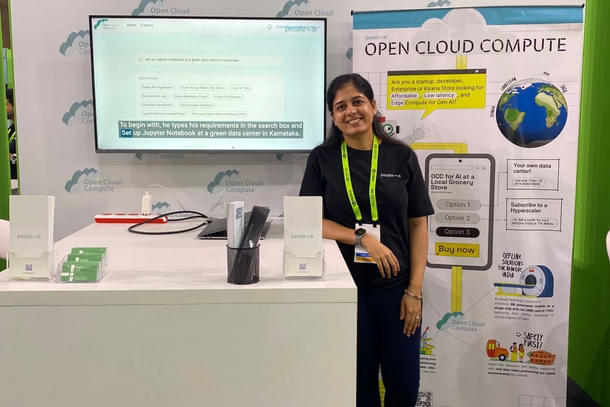
‘A Resource Catalogue’
Tanvi and team got OCC off the ground in October 2024. They onboarded two domestic compute providers to kick things off — Mysuru-based Vigyanlabs and Coimbatore-based Jarvislabs. They are also in talks with other providers. Certain resource offerings from Vigyan and Jarvis have been made available on the network.
OCC is “very much a resource catalogue,” Tanvi says. “Think of it as an ONDC. But the “DC” here is ‘data centre’.”
Indian data centres, which are few in number and living in the shadows of mega data centres, have much to gain from an effort like the OCC. For one, domestic data centres operate as standalone businesses. They are not recognised as a particular category or grouping of business. As a result, they do not enjoy the benefits typically accrued by virtue of category recognition. Moreover, since they operate alone, there is an absence of a sense of a ‘compute community’.
Tanvi explains this idea through a comparison with the highly recognisable “MSME” category. MSME is short for micro, small, and medium enterprises. “When you think of MSMEs, there is an MSME Act. And you know there are 63 million MSMEs. And if you are part of that category, you get certain benefits when it comes to financial subsidies, getting credit from banks, etc.” Such beneficial categorisation currently eludes India’s compute suppliers.
OCC then can at least put these data centres on the map, create a foundation for many more to come up, introduce a sense of community among the compute players, and present a case for data centres — especially “micro data centres” — to eventually qualify for special incentives from governments, financial institutions, and other stakeholders.
It could pave the way for, for instance, “data centre parks” in the vein of “software technology parks.” That would bring data and compute closer together for the sake of high-bandwidth, low-latency connectivity. These parks could host micro data centres with a capacity of 25-300 kW and occupying just around 800 to 3,000 square feet that would handle critical CPU and GPU workloads. Such developments would catalyse the proliferation of AI and associated technology development in India.
“I spoke to Tanvi from People+AI,” says Vishnu Subramanian of Jarvislabs, a GPU cloud platform in Coimbatore, Tamil Nadu, and one of two players on the OCC network. “They were sharing their vision of what India would need to take AI and apply it to Tier 2, Tier 3 in education and medical (space). I understood that not one single company can do it. I don't think even AWS, GCP can go to that level because it needs heavy subsidisation, or it needs optimisation at different levels. That's where their vision of, let’s say, there are hundreds of smaller data centres and there are one or two players who can club them all and offer them a market for both India and outside India made a lot of sense.”
Jarvis was among the earliest to rise in the cloud compute space in India. “I started Jarvislabs because there was no one doing it in India. Most of the tech products that we see are mostly built outside India. That's where we wanted to come in, and that's why we invested in our own servers when no one else was doing it.”
For one example of how Jarvis teaming up with OCC can be beneficial, Subramanian explains: “If someone wants to put up a data centre in Coimbatore, what they need to do is they need to have a software stack. They also need to have a sales team. They would have a lot of things to actually go and sell, which is complicated. So OCC and even Jarvislabs can offer them a place where they can easily take it to the end consumers. That's one solution that I really like.”
Compute providers are only one of two parties involved. Seated across the table from them are the compute consumers. People+ai sees education and healthcare as two spaces where the introduction of OCC could bring a great deal of value. The not-for-profit has already begun its outreach to the student community. One reason is that the community is huge — over 4 crore students are enrolled in the higher education system, nearly 79 per cent of them at the undergraduate level.
But the size is not all. Students, especially in the computer science and allied streams at the undergraduate level, have some room to experiment and grow their skills in the nascent field of AI. They “look for compute but not just compute,” says Tanvi. “They are new to the industry. They are also saying, ‘We are excited about AI. What do we build?’ So there we thought OCC’s value proposition could be more than compute.”
Undergraduate students should find it easy to use OCC because it’s designed to be beginner-friendly. “If you look at the interface, it’s not just, oh, you see an instance of an A100 with 50 GB storage — which is typically what a developer sees — but we are also saying you can search by use case,” Tanvi says.
What that means is that if a student knows, for instance, that they want to work on computer vision for their college project, they only need to type in “computer vision” on OCC. That will serve up suitable compute configurations to choose from. In the absence of this ‘search by use case’ feature, a student would have to figure out the exact compute requirements of their project by themselves. While that may not be easy for someone just starting out, it could also prove to be a barrier on the path of a student who is taking their first steps in innovation.
“Honestly, compute is not hard,” reminds Tanvi. “But it’s the knowledge around how you use it, how you derive value from it, (and) if I am new to this space, what do I do? That is what we try to package.”
Trial By Students
Leaning towards an implementation bias, Tanvi put her initial OCC offering to the test at PES University, Electronic City campus, in October. It was People+ai’s first-ever hackathon. They sponsored it. Students in their second year of engineering studies, 60 of them, were presented with the network so they could select from a range of compute resources for their projects through the use of ‘compute credits’. The projects were largely based on natural language, computer vision, and data analytics.
The students had the choice of offerings from Vigyanlabs and Jarvislabs. “We offered our compute as part of the hackathon. Students were using our thing, and I think they had a good experience,” Subramanian says.
“The hackathon went well,” says Tanvi. She was there with her colleagues Asif Hassan and Shreya Mandi to support the exercise and troubleshoot issues if they cropped up. “The pilot interface worked. Nothing really came up. Because the functionality of the website is quite simple. It's a resource catalogue at the end of the day.” It helped that the brightest teams participated in the hackathon.
As expected, the use-case filter was a hit. Asif confirms that to me, reiterating that the hackathon “turned out well.” Besides searching by use case, students had the option to pick out the graphics processing unit (GPU) chip of their choice, such as the H100, if they knew beforehand that’s what they wanted, or look up the cloud provider of their preference if they had one.
There were also students working on data-hungry projects who were simply looking for data storage-intensive resources on OCC. This is helpful because the public cloud doesn’t offer the kind of data storage necessary for data-intensive projects. And in comparison to public cloud, domestic compute suppliers offer their resources at just 60-70 per cent of the price.
“I think what the hackathon did for the university is it gave them confidence that something like this could work,” Tanvi says, admitting that it was a new process even for People+ai. “We saw the use cases that came out of the hackathon. It gave us a good sense of what happens at a hackathon. Next time we do it, we will probably add a few more categories and refine the list of use cases that get presented,” she says.
More advanced students, such as those pursuing a master’s or a Doctor of Philosophy (PhD) degree, would benefit similarly from OCC. But that would be quite a step up for the network at present. Little would change with how one interacts with the interface; however, the compute demands of, say, a PhD student working on a years-long project would be significantly higher than what People+ai is offering now.
Tanvi says, however, that if such a demand exists, she would take it to the compute providers. “If we say there is a pocket of demand here, say we feel that 10 students from PES, hypothetically, if they had OCC and they would sign up for it, but they would need this much capacity — say they would need an H100 for a week every month and a huge amount, like 500 GB worth, of storage capacity — then you have to ensure that providers on the other hand are set up or want to do it.”
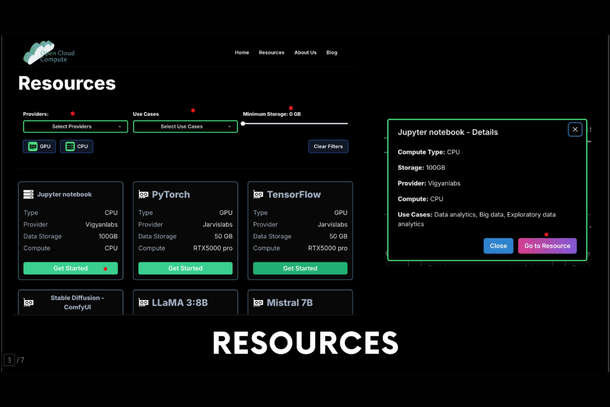
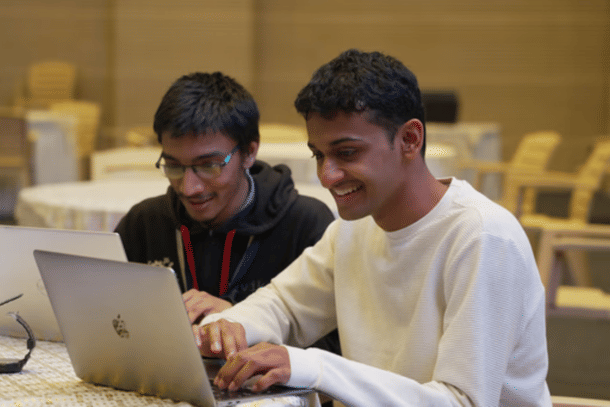
Finance, Healthcare Startups Next
While students are a great draw for OCC, the student community alone cannot justify OCC, at least not on the scale that People+ai is envisioning. For one, universities are disaggregated. Reaching out to them individually is hard work. But also, students fall under the high-volume, low-cost category. They naturally get drawn to the free or lower-paid plans. That is not helpful for People+ai’s goal of market validation of OCC.
Tanvi and the team are, therefore, looking at startups too — better if they are tech startups or engaged in building AI applications — “who need a lot of compute, who end up spending a lot of money.”
However, “tech startup” is a large and vague category. Targeting specific sectors to showcase the benefits of OCC would be the smarter thing to do. So Tanvi and team have made the call to take their network subsequently to banking, financial services, and insurance (BFSI) organisations and healthcare companies.
The finance and healthcare sectors have some similarities — the amount of data transacted is typically high, and data localisation is a necessity, for example. “There are data compliance laws, data security (needs), which require you to have your data stored either on your campus or close to you or in your control. Data ownership and governance is huge. So there we felt the local domestic compute made sense. There was synergy with it,” Tanvi says.
People+ai is now in the process of researching and designing offerings specific to the BFSI and healthcare sectors. The healthcare space in particular is close to Tanvi’s heart. After studying biochemistry at the undergraduate level at Delhi University, biotechnology management at the master’s level at Carnegie Mellon, and a Master of Business Administration (MBA) at the Haas School of Business, University of California, Berkeley, she worked for about eight years in the Bay Area with a medical devices startup, where she managed strategy and planning.
Tanvi’s penchant for healthcare brought her to People+ai too. “One of the reasons why I joined People+ai was because in healthcare in general not much tech is used. New drugs, new vaccines, new diagnostic tests — everything is very lab-based. So when I was moving back to India, I was trying to figure out how AI — tech in general, or software — can augment that healthcare journey. Because I felt like it was very, very slow. That’s how I came across this team,” she says.
Besides picking up crucial experience in the healthcare vertical, Tanvi has kept herself close to the users of healthcare products and services. “I very much come from a world of being close to the user. My last product was also where you gave the diagnostic test to the user — the rapid Covid test; that’s exactly what we were making.” This makes her well equipped to understand and identify the compute needs of the healthcare sector.
“There are so many AI companies in India. You try to figure out how they can be helping Indian health outcomes. One basic thing lacking is the compute. Like what is stopping an AI developer from selling to a PHC (primary health centre) or a community health centre? It's likely going to be the compute,” Tanvi says.
For their healthcare offering, People+ai is thinking about how they can install simple compute infrastructure in last-mile healthcare centres and clinics, which, according to Tanvi, “can help them create community medical records, which maybe today are not possible because a lot of these spaces are not digitised.”
What their BFSI and healthcare offerings look like will become clearer in the next few months with the release of a publication where it will all be documented. “Even if we cover five case studies, we are trying to pick out areas, domains in India which would really benefit from Edge,” Tanvi says.
Edge compute refers to the processing of data close to where it’s created, like on the smartphone or in a nearby device, rather than having it shipped and processed on a faraway central computer or server (like in the cloud).
“We are even thinking about video surveillance at the Edge. It could be CCTV coverage happening in your house. It could be imaging happening at a toll, which again requires very low latency and quick response. It could be something happening at the civic body level where they are monitoring roads. Another space is agriculture, where you have agri AI getting built. You know it's not going to be in Tier 1 cities, for sure. What would that look like? So we are writing out a few of these case studies right now.”
Compute Will Power AI Use Cases
Though compute is a vital cog in the AI wheel and is also what the OCC is primarily centred around, the larger goal is to facilitate the development of AI applications on a population scale.
“Compute is one part of our world because we feel it’s foundational infra. But honestly, the majority of our work is in use cases,” says Tanvi. “Figuring out actually what is that problem statement and AI solution, which, if paired together, would improve outcomes. So we are pursuing projects in healthcare, education; there’s a whole breadth of projects we do.”
The use-case focus seems to stem from the vision of Nilekani, co-founder and director of the EkStep Foundation, who regularly advocates for India to become “the use-case capital of the world.” “The Indian path in AI is different,” Nilekani said at the launch of OCC in May this year. “We are not in the arms race to build the next LLM (large language model). Let people with capital, let people who want to pedal chips do all that stuff... We are here to make a difference, and our aim is to give this technology in the hands of people.”
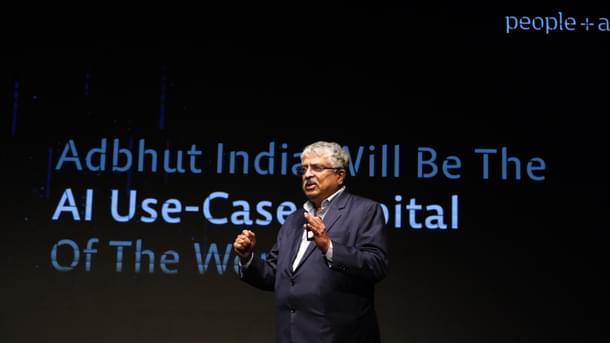
Being a use-case capital means that “many, many AI applications are going to come up in very different, diverse domains,” says Tanvi, and in which case all of that “has to run on something.”
“If we are a billion people using an AI application every day, even once, that means a billion AI queries and responses have to happen. So, what Nandan says, and I've heard this repeatedly from him, is that we are high volume and low cost. And if we are high volume, then compute needs to be there to support that.”
After the compute layer is set down, it would then become a launchpad for India-focused AI use cases. “For example, you want to deploy something like Lama 3.2 to all school kids in some use case. Then you need a very affordable solution. So this kind of thing made me feel OCC is super important. Getting it successful is very tough. Again, UPI, Aadhaar were also tough. These guys pulled it off. So I want to be part of it,” Subramanian of Jarvis says.
With OCC, India’s emerging AI developers may finally have a place to go to reliably meet their cloud compute needs, and at a cost and customisation that works for them. If it works out, OCC could spur AI growth in India in a decisive way.
Karan Kamble writes on science and technology. He occasionally wears the hat of a video anchor for Swarajya's online video programmes.





